LAS VEGAS — Kenworth’s SuperTruck 2 is stunning in appearance — especially at night.
The cab and underpinnings are lit in red LEDs, offering a menacing accompaniment to the aerodynamic slopes and curves of the roofline and blacked-out, hulking grill.
The truck made its debut on May 21 at the ACT Expo in Las Vegas.
It was developed over a six-year period as part of a collaboration with the Department of Energy’s (DOE) SuperTruck program, designed to challenge truck makers to improve freight efficiency using a diesel engine as the main power source.
The project was the result of a joint investment by the DOE and PACCAR.
“The goal was a 100% freight efficiency improvement over our 2009 Kenworth T660, which at the time was arguably the most fuel-efficient truck in the industry. We surpassed the performance of that model to improve efficiency by up to 136%,” said Jim Walenczak, general manager of Kenworth and PACCAR vice president. “This was realized through a combination of improving fuel efficiency up to 12.8 mpg while reducing our combination weight by more than 7,000 pounds. The result was the ability to haul more payload with an ultra-fuel-efficient tractor-trailer combination. SuperTruck 2 provided us with the opportunity to investigate new technologies in an early stage. We learned what worked and what didn’t. As a result, we are able to commercialize new technologies much quicker than we would have otherwise.”
The unique look of the Kenworth catches most of the attention, but the powertrain and driver amenities are just as impressive.
“We started with an ideal aerodynamic shape when we started the design of SuperTruck 2,” said Joe Adams, Kenworth’s chief engineer. “At the start of the project, we asked ourselves, ‘What does the next generation vehicle for long haul transportation look like?’ What we produced pushes the limits in reducing aerodynamic drag while it also incorporates a new powertrain. But, with everything Kenworth, we wanted the SuperTruck 2 to embody ‘The Driver’s Truck’. The result was a systematic approach to developing a futuristic looking, yet relevant vehicle with technologies that have the potential to be refined and commercialized.”

From an engine and transmission standpoint, Kenworth’s SuperTruck 2 utilizes a PACCAR MX-11 engine, rated at 440 hp, which is driven through a PACCAR TX-12 automated transmission. In addition, the truck features a 48-volt electric generator.
This creates a “mild” hybrid system and leverages next generation lithium-ion batteries. The batteries are re-charged through regenerative braking. This allows Kenworth’s SuperTruck 2 to operate electric fans, electric steering, and power for electric coolant and HVAC pumps, which were previously mechanically driven. The engine fan alone can draw up to 80 horsepower.
The hybrid system also provides an overnight engine-off “hoteling” solution. In addition, the 48V generator powers the exhaust heater in the in-house developed close coupled aftertreatment system which demonstrated CARB 2027 ultra-low NOx compliancy.
The SuperTruck 2 team managed a parallel project for energy efficiency testing by combining a PACCAR MX-11 based engine, the mild hybrid based 48-volt auxiliaries and energy waste recovery to bench test a program record 55.7% engine efficiency.
“We did this while keeping in mind the technologies we developed needed to be commercially viable,” said Maarten Meijer, PACCAR’s senior engineering manager for advanced technology. “Today’s modern diesel engine demonstrates around 47% efficiency. Reaching 55.7% was a major step forward and could only be done by applying new technologies that had not been explored until today. To put that efficiency number into perspective, if this engine were to go into production, it would lead to a 10% fuel efficiency improvement. That’s an astonishing number.”
The unique look of Kenworth’s SuperTruck 2 features a “center driver” cab, along with a new sleeper compartment.
It’s a look that resembles a bullet train.
“We wanted to push this beyond just a demonstrator truck,” said Jonathan Duncan, Kenworth’s design director. “We wanted to show something dynamic and what the future of Kenworth might look like. Our headlamps take up the entire front fender of the truck. It’s striking — you can’t miss it as it’s going down the road.”
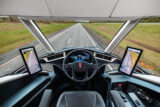
The aerodynamic design was enabled thanks in part by the location of the powertrain content, which fits between the frame rails. This also allowed the engine to be lowered and placed behind the front axle. A reverse- splayed chassis allowed the engineering team to narrow the front of the truck and fully enclose the wheels within the bodywork. The entire hood and the chassis fairings were mounted directly to the cab, and they move with the entire cab as one unit.
A variable suspension system was developed to customize ride height and optimize aerodynamics — Kenworth’s SuperTruck 2 can be raised over rough roads to avoid obstacles, then brought back down when running over smoother interstates. Combined, the sleekness means a 48% reduction in drag as compared to Kenworth’s baseline vehicle.
Even though SuperTruck 2 is powered by a diesel engine, Kenworth is thinking toward the future. The overall layout was designed to be powertrain agnostic. To support zero and near-zero emission solutions, the truck can efficiently package fuel cells, hydrogen tanks, natural gas tanks, or batteries without changing the basic cab.
Enabling more payload was a critical element in the design for the Kenworth engineering team, which also utilized a design specific trailer to go with the tractor. The combination came in at 26,100 pounds — 7,100 pounds less than a typical tractor-trailer configuration (4,100-pound savings on the tractor; 3,000 on the trailer).
“These savings would give a fleet the option of running lighter with the same amount of goods they’d normally put in a trailer, or they could add 7,100 more pounds of payload,” Adams said. “There were a lot of things that contributed to weight savings. The 10 new concept tires we used weighed 355 pounds less than ‘like’ tires currently on the market, and those tires also had an extremely low rolling resistance — measuring 4.2 on the CRR scale versus 5.0 for typical high-efficiency tires. We also found that less fuel was required with the more fuel-efficient powertrain – this allowed us to put on a smaller 80-gallon fuel tank to go the same distance as before. So, here again, we’re saving weight. It all builds upon itself.”
Climbing into the truck is altogether different.
The driver-side door has a large opening, and the extendable bottom step supports a stairway-like entry and exit. Drivers have easy-viewing electronics at their disposal — SuperTruck 2 features PACCAR’s state-of-the-art 15-inch digital display, with a configurable gauge layout, advanced driver notifications, and a user-friendly menu navigation.
Once behind the wheel, drivers have a view like nothing else in the trucking industry.
“We made the windshield very parabolic in plain view and smooth to the flow. We also went one step further and eliminated physical mirrors altogether, minimizing drag,” Duncan said.
“The integrated digital mirror system enables enhanced rear-view monitoring, with trailer tracking capability and night vision enhancements, technology currently available in Kenworth T680 models.”
For drivers off hours, Kenworth took the extra step to design a unique sleeper berth.
“One of the features we’re trialing is a bed that folds down over the sofa,” Duncan said. “This provides a separate sleeping and sitting area. We also came up with a neat concept: having a tabletop that rotates down when you’re sitting on the sofa. You can actually eat or work then move the table to a different location without moving anything off the tabletop.”
All told, Kenworth’s SuperTruck2 gives not only a potential glimpse of the future but new ideas for consideration.
“Working in the trucking industry is very exciting,” Adams said. “There are major challenges ahead as we continue to advance vehicle performance, all while keeping in mind the goal to be a carbon neutral society by 2050. This will require tremendous technology changes in the trucking industry and partnering with the DOE on the SuperTruck 2 program was a tremendous opportunity to consider what will be possible as we look toward the future.”
The Trucker News Staff produces engaging content for not only TheTrucker.com, but also The Trucker Newspaper, which has been serving the trucking industry for more than 30 years. With a focus on drivers, the Trucker News Staff aims to provide relevant, objective content pertaining to the trucking segment of the transportation industry. The Trucker News Staff is based in Little Rock, Arkansas.








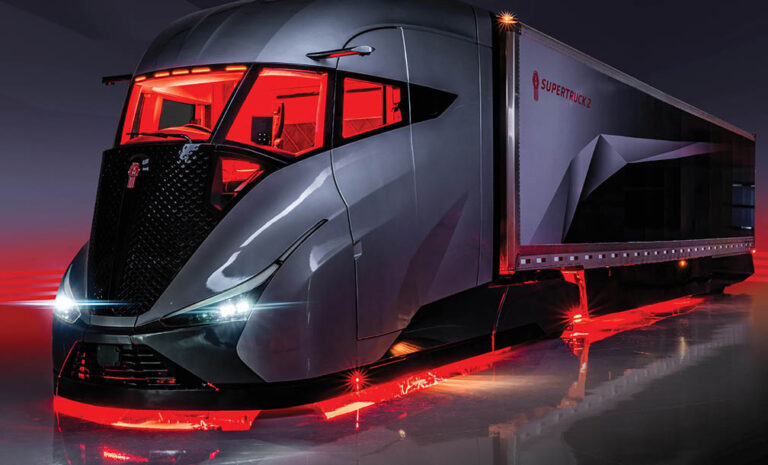

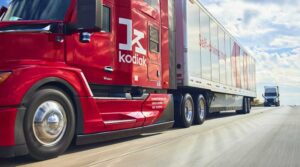
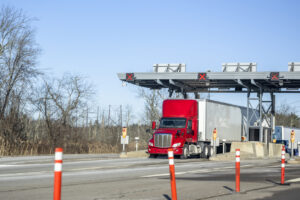
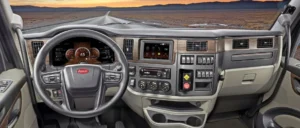



These trucks should be placed on the road immediately. As development continues, they can be upgraded with the refinements. Other propulsion systems electric, FuelCell, hydrogen can also be tested on the road as quickly as possible. Why wait ? test them in real life situations as soon as possible. Time is running out.
Initially Kenworth can own the trucks, provide what training is needed for the drivers and pay them enough to make it worth their while. Once the trucks are refined and proven, the present “owner/operator” model can be offered again if desired.